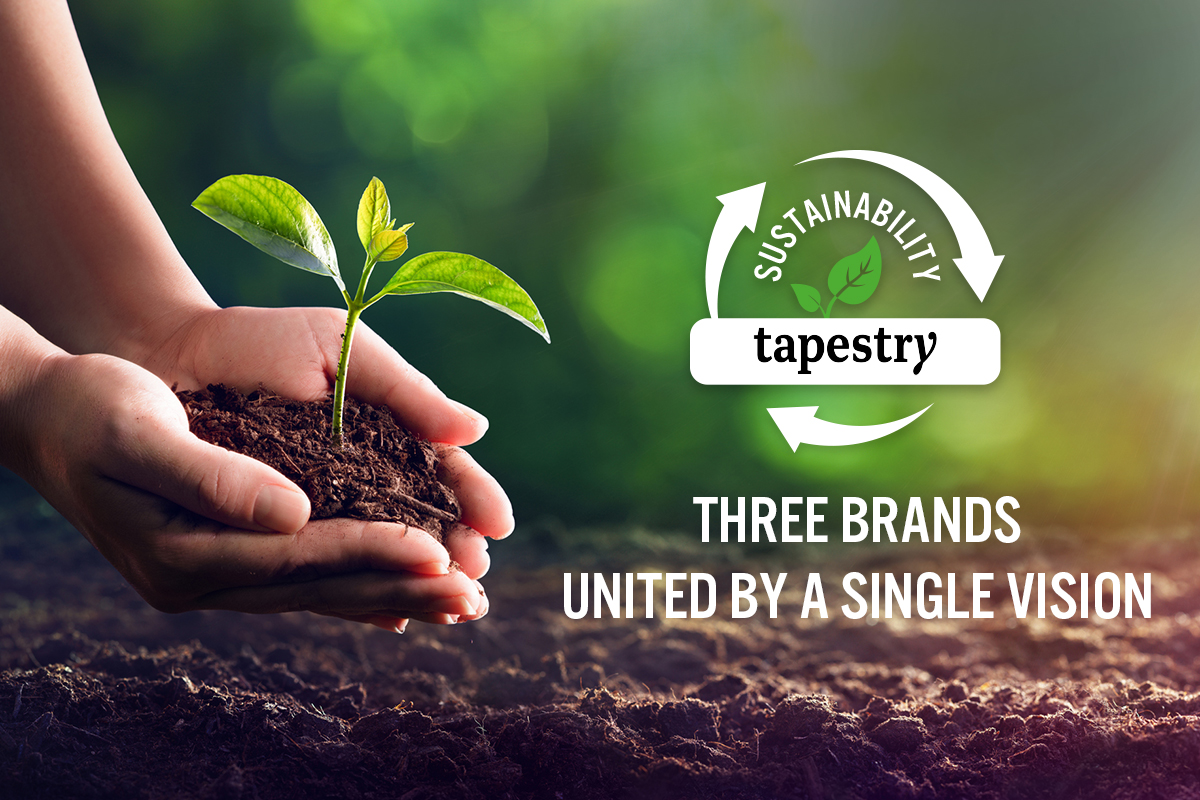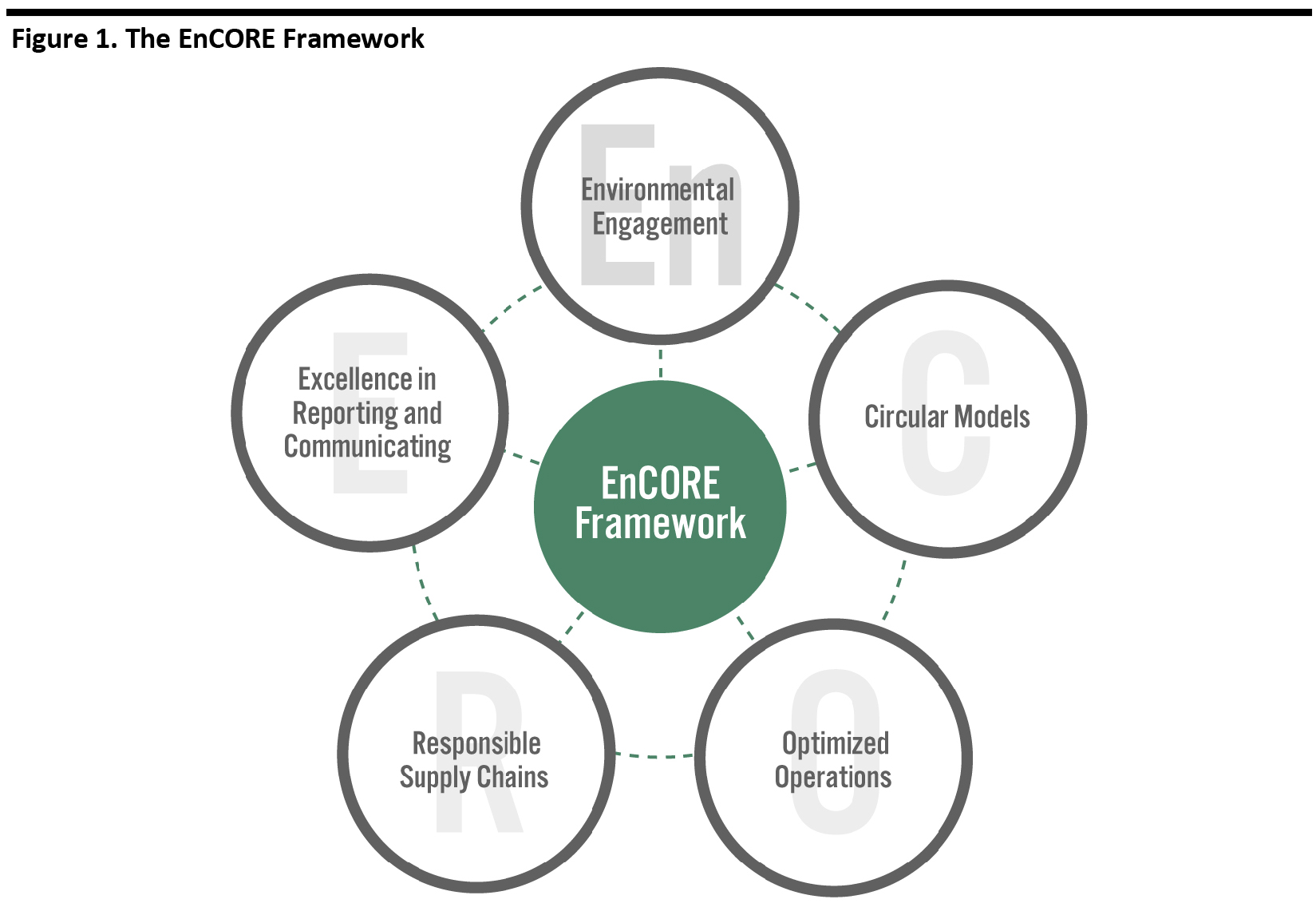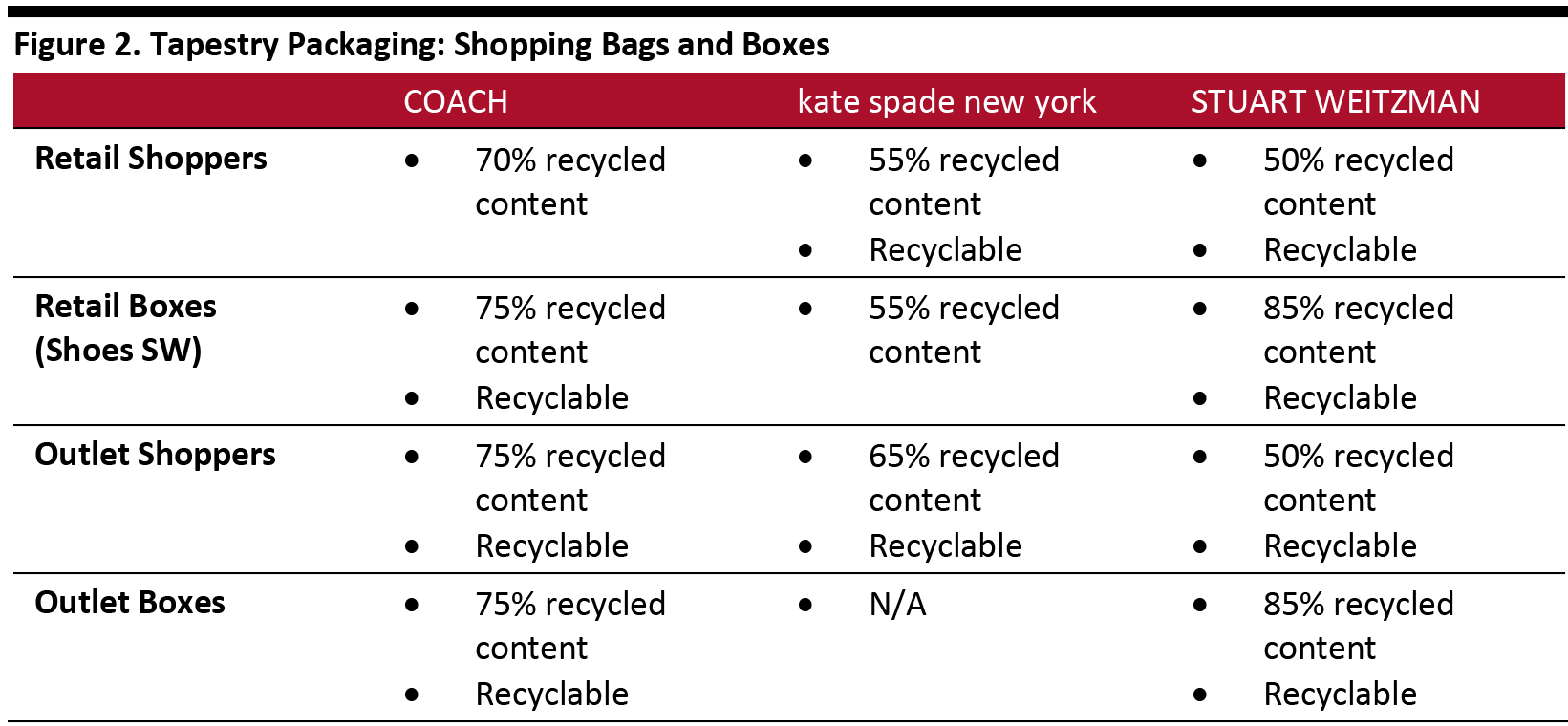
DIpil Das
Tapestry is a US-based multinational luxury fashion holding company with three brands: Coach, Kate Spade New York and Stuart Weitzman. On April 29, 2020, the company released its 2019 Corporate Responsibility Report, entitled Our Social Fabric which details the company’s commitments to people, the planet and the community, as well as outlining its immediate and long-term goals in the midst of the Covid-19 pandemic.
In this report, we explore the evolution of Tapestry’s corporate responsibility commitments and the company’s future goals.
 Source: Coresight Research[/caption]
Consideration of the environment is being driven on a global scale. The 2030 Agenda for Sustainable Development was adopted by all United Nations (UN) Member States in 2015. It is described by the UN as a “blueprint to achieve a better and more sustainable future for all” and is centered around 17 Sustainable Development Goals (SDGs). Below are the SDGs that most directly align with EnCORE.
Source: Coresight Research[/caption]
Consideration of the environment is being driven on a global scale. The 2030 Agenda for Sustainable Development was adopted by all United Nations (UN) Member States in 2015. It is described by the UN as a “blueprint to achieve a better and more sustainable future for all” and is centered around 17 Sustainable Development Goals (SDGs). Below are the SDGs that most directly align with EnCORE.
 Source: Company reports [/caption]
Tapestry is optimizing operations (in alignment with SDG #7) to reduce its carbon footprint and is measuring its impact via Scope 1 and Scope 2 CO2e greenhouse gas emissions—targeting a 20% reduction by 2025. The company achieved an overall 0.4% reduction in CO2 emissions across all stores from 2018 to 2019, as retrofitting stores with LED lights offset the impact of its 240,000-square-foot increase in total store space. Tapestry’s distribution centers reduced emissions by 2.2% in 2019 as well.
Tapestry’s three brands have increased their purchases of renewable energy via Renewable Energy Certificates, increasing from 1,335MWh to 3,443MWh in 2019. Tapestry is hoping to achieve 100% renewable energy by 2025, in accordance with the UN’s SDG #7. Shipping emissions—both air and sea—have also been reduced by 5.6% over a 2017 baseline, and the company is seeking to achieve an overall reduction of 20% by 2025. Overall, Tapestry’s carbon footprint has been reduced by 6.7% since 2017, and for the past five years, Tapestry has received a “C” score from the CDP in its climate change survey (with “A” being the highest possible score).
Water conservation has also been a key aim for the company (in alignment with SDG #6), and Tapestry has decreased its global water consumption by 9% in the past two years—including a 4.6% decrease in total water usage to 10,706,873 gallons in 2019. For the past four consecutive years, the company has received a “C” score from the CDP.
Source: Company reports [/caption]
Tapestry is optimizing operations (in alignment with SDG #7) to reduce its carbon footprint and is measuring its impact via Scope 1 and Scope 2 CO2e greenhouse gas emissions—targeting a 20% reduction by 2025. The company achieved an overall 0.4% reduction in CO2 emissions across all stores from 2018 to 2019, as retrofitting stores with LED lights offset the impact of its 240,000-square-foot increase in total store space. Tapestry’s distribution centers reduced emissions by 2.2% in 2019 as well.
Tapestry’s three brands have increased their purchases of renewable energy via Renewable Energy Certificates, increasing from 1,335MWh to 3,443MWh in 2019. Tapestry is hoping to achieve 100% renewable energy by 2025, in accordance with the UN’s SDG #7. Shipping emissions—both air and sea—have also been reduced by 5.6% over a 2017 baseline, and the company is seeking to achieve an overall reduction of 20% by 2025. Overall, Tapestry’s carbon footprint has been reduced by 6.7% since 2017, and for the past five years, Tapestry has received a “C” score from the CDP in its climate change survey (with “A” being the highest possible score).
Water conservation has also been a key aim for the company (in alignment with SDG #6), and Tapestry has decreased its global water consumption by 9% in the past two years—including a 4.6% decrease in total water usage to 10,706,873 gallons in 2019. For the past four consecutive years, the company has received a “C” score from the CDP.
History of ESG at Tapestry
In 2001, Tapestry’s first year as a public company, the company (then Coach, Inc.; it changed its name in 2017) published its Supplier Code of Conduct and established a social auditing program—both of which focused on social and environmental compliance, communicating its expectations of suppliers regarding fair working conditions, wages and safety. The company embarked on a dedicated ESG strategy in 2008 and has since deepened its commitment to its ESG efforts—“increasing volume and reach” across the organization, its brands and operations, according to Logan Duran, Tapestry’s Director of Sustainability. Duran was part of the original team charged with simple baseline goals of regulatory adherence regarding safety and packaging at Coach; today, environmental and social measures are implemented throughout the organization and its three brands, as Duran and his team support and drive growing internal demand for accountability in all areas of ESG. By 2013, Tapestry had instituted its formal sustainability and social governance program, and the company subsequently expanded its reporting to external agencies, including through the CDP’s climate change, water and forests surveys. In 2015, Tapestry introduced its first set of corporate responsibility goals, which focused on climate change, water, waste management and social issues, and the company began reporting its progress annually. In 2018, Tapestry signed onto the United Nations (UN) Global Compact, joining more than 9,800 corporate signatories. Attention to sustainability begins with Tapestry’s engaged C-suite, through which lifecycle assessments and global reporting initiatives (GRIs) quantify and measure progress. Today, Tapestry believes that good governance and attention to social values and community are “table stakes and integral to doing business,” according to Duran. Over the past eight years, Tapestry has evolved into a corporate leader for ESG in the modern luxury/accessories space. Tapestry has an ESG taskforce that meets monthly, which is co-sponsored by two members of senior leadership—the Chief Operations Officer and Chief General Counsel (currently the Acting President of Coach)—and involves leadership members and representation from all areas of the company: supply chain; marketing and communications; global environment (stores and facilities); the Coach Foundation; the Kate Spade New York Foundation; human resources; and Duran’s sustainability team. The ESG effort is comprehensive, and as a $6 billion company, Tapestry has the scale to make a difference and set an example of the positive impact that corporations—particularly in the luxury sector—can have on the planet and the community.Tapestry’s 2025 Corporate Responsibility Goals
The company’s ESG goals span people, the planet and the community. In keeping with the environmental thrust of Coresight Research’s proprietary EnCORE framework, we focus on Tapestry’s goals for the planet:- A 20% reduction in absolute Scope 1 (direct emissions) and Scope 2 (indirect purchased emissions) CO2e emissions and a 20% reduction in absolute Scope 3 (indirect emissions from suppliers and consumers) CO2e emissions from freight shipping over a 2017 baseline
- 95% traceability and mapping of raw materials to ensure a transparent and responsible supply chain
- 90% of leather to come from Silver- and Gold-rated Leather Working Group tanneries (from 63% in 2019)
- 75% recycled content in packaging (from 40% currently) and a 25% reduction in North American corporate and distribution-center waste
- A 10% reduction in water usage across Tapestry and the supply chain
ESG at Tapestry Through the Lens of Coresight Research’s EnCORE Framework
We developed the EnCORE framework to help retailers and brands frame their approach to environmental sustainability. Our goal is to provide a way of systematically thinking about sustainability and criteria that are most helpful to internalize a sustainability strategy in the retail ecosystem. [caption id="attachment_116982" align="aligncenter" width="700"] Source: Coresight Research[/caption]
Consideration of the environment is being driven on a global scale. The 2030 Agenda for Sustainable Development was adopted by all United Nations (UN) Member States in 2015. It is described by the UN as a “blueprint to achieve a better and more sustainable future for all” and is centered around 17 Sustainable Development Goals (SDGs). Below are the SDGs that most directly align with EnCORE.
Source: Coresight Research[/caption]
Consideration of the environment is being driven on a global scale. The 2030 Agenda for Sustainable Development was adopted by all United Nations (UN) Member States in 2015. It is described by the UN as a “blueprint to achieve a better and more sustainable future for all” and is centered around 17 Sustainable Development Goals (SDGs). Below are the SDGs that most directly align with EnCORE.
- #6: Clean Water and Sanitation—Avoid wasting water
- #7: Affordable and Clean Energy—Use energy-efficient appliances and lightbulbs
- #12: Responsible Consumption and Production—Recycle paper, plastic, glass and aluminum
- #13: Climate Action—Stop global warming
- Environmental engagement—A key component of engagement is understanding. This involves dissecting one’s operations and supply chain (internal and external processes) and analyzing peer practices and industry shifts. Businesses should seek the opinions of all stakeholders—including employees and investors—while evolving to meet consumer sustainability demands. This process can be aided by external assistance, such as from third-party research companies, advisory groups or non-governmental organizations, as well as industry peers.
- Circular models—Minimize the environmental impact of products and maximize the recirculation of materials back into use. The key to building circular models is to design waste out of processes across the supply chain and choose materials that can be repurposed in closed recycle-and-reuse loops. Retailers striving towards zero waste should measure consumption, waste and recycling rates to find opportunities for improvement, and often the end of a product’s life is a good place to start.
- Optimized operations—Use more resource-efficient infrastructure and decarbonization technologies to cut down the use of resources and reduce environmental impact.
 Source: Company reports [/caption]
Tapestry is optimizing operations (in alignment with SDG #7) to reduce its carbon footprint and is measuring its impact via Scope 1 and Scope 2 CO2e greenhouse gas emissions—targeting a 20% reduction by 2025. The company achieved an overall 0.4% reduction in CO2 emissions across all stores from 2018 to 2019, as retrofitting stores with LED lights offset the impact of its 240,000-square-foot increase in total store space. Tapestry’s distribution centers reduced emissions by 2.2% in 2019 as well.
Tapestry’s three brands have increased their purchases of renewable energy via Renewable Energy Certificates, increasing from 1,335MWh to 3,443MWh in 2019. Tapestry is hoping to achieve 100% renewable energy by 2025, in accordance with the UN’s SDG #7. Shipping emissions—both air and sea—have also been reduced by 5.6% over a 2017 baseline, and the company is seeking to achieve an overall reduction of 20% by 2025. Overall, Tapestry’s carbon footprint has been reduced by 6.7% since 2017, and for the past five years, Tapestry has received a “C” score from the CDP in its climate change survey (with “A” being the highest possible score).
Water conservation has also been a key aim for the company (in alignment with SDG #6), and Tapestry has decreased its global water consumption by 9% in the past two years—including a 4.6% decrease in total water usage to 10,706,873 gallons in 2019. For the past four consecutive years, the company has received a “C” score from the CDP.
Source: Company reports [/caption]
Tapestry is optimizing operations (in alignment with SDG #7) to reduce its carbon footprint and is measuring its impact via Scope 1 and Scope 2 CO2e greenhouse gas emissions—targeting a 20% reduction by 2025. The company achieved an overall 0.4% reduction in CO2 emissions across all stores from 2018 to 2019, as retrofitting stores with LED lights offset the impact of its 240,000-square-foot increase in total store space. Tapestry’s distribution centers reduced emissions by 2.2% in 2019 as well.
Tapestry’s three brands have increased their purchases of renewable energy via Renewable Energy Certificates, increasing from 1,335MWh to 3,443MWh in 2019. Tapestry is hoping to achieve 100% renewable energy by 2025, in accordance with the UN’s SDG #7. Shipping emissions—both air and sea—have also been reduced by 5.6% over a 2017 baseline, and the company is seeking to achieve an overall reduction of 20% by 2025. Overall, Tapestry’s carbon footprint has been reduced by 6.7% since 2017, and for the past five years, Tapestry has received a “C” score from the CDP in its climate change survey (with “A” being the highest possible score).
Water conservation has also been a key aim for the company (in alignment with SDG #6), and Tapestry has decreased its global water consumption by 9% in the past two years—including a 4.6% decrease in total water usage to 10,706,873 gallons in 2019. For the past four consecutive years, the company has received a “C” score from the CDP.
- Responsible supply chains—Retailers should look to implement less-resource-intensive processes, more responsible sourcing, enhanced raw-material traceability and greater overall transparency for the consumer.
- Excellence in reporting and communicating—Consumers are demanding more transparency across the supply chain than ever before, and companies that provide this build consumer trust and loyalty. Retailers and brands that share greater granularity across business processes are communicating responsibility for their choices and willingness to be held accountable for actions.